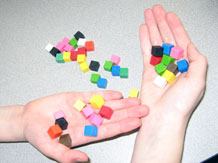How can we measure the volume of a liquid?
2. Explore centimeter cubes


As students explore the centimeter cubes, explain that scientists have designed a way to measure how much space something takes up. They use a unit of measure called a cubic centimeter, which takes up exactly as much space as the cube they hold in their hands. Point out that every edge of the cube is exactly one centimeter long.
- Can you show me with your fingers how much space a cubic centimeter takes up? Be sure you think 3-D!
- Can you think of something that has a volume of just 1 or 2 or 3 cubic centimeters?
One M&M candy has a volume of less than 1 cubic centimeter; a large blueberry, a tooth, or a pencil eraser can have a volume close to 1 cubic centimeter. A marble may have a volume of close to 2 cubic centimeters.
Demonstrate how you can use centimeter cubes to measure and describe the amount of space something takes up. For example, you can get an approximate measure of the amount of space inside your closed hand by scooping up cubes and counting. Keep adding cubes until you can no longer wrap your fingers around them without some of them showing, then let the class know the results.
It looks like my hand can hold about [XX] cubic centimeters of stuff.
Students may point out that the volume is actually greater because there are spaces between the cubes in your hand. Acknowledge this observation.
Distribute a cup of centimeter cubes to each group and ask each student to measure the volume of their own closed fist in the same way. When students finish, do a quick "show of hands" survey of the results.
- How many people had more than 10 cubic centimeters of space inside their closed fist? How many had more than 15 cubic centimeters of space inside their closed fist?
Have students use the cubes to estimate the volumes of some other solid objects nearby, perhaps a pencil, or a whiteboard eraser, or an apple. Continue to ask for estimates throughout the lesson, so students can get practice with the new unit of measure.
Centimeter cubes and cubic centimeters: Students may be confused at first about the difference between centimeter cubes and cubic centimeters. Centimeter cubes are the physical cubes, often made from wood or plastic; they have a dimension of one centimeter along each edge. A cubic centimeter is the amount of space that a centimeter cube takes up; it is a standard measure for volume.
If you sense confusion, ask, "Are you talking about the object, or are you talking about the volume (or, the amount of space it takes up or, the unit of measure)?"



